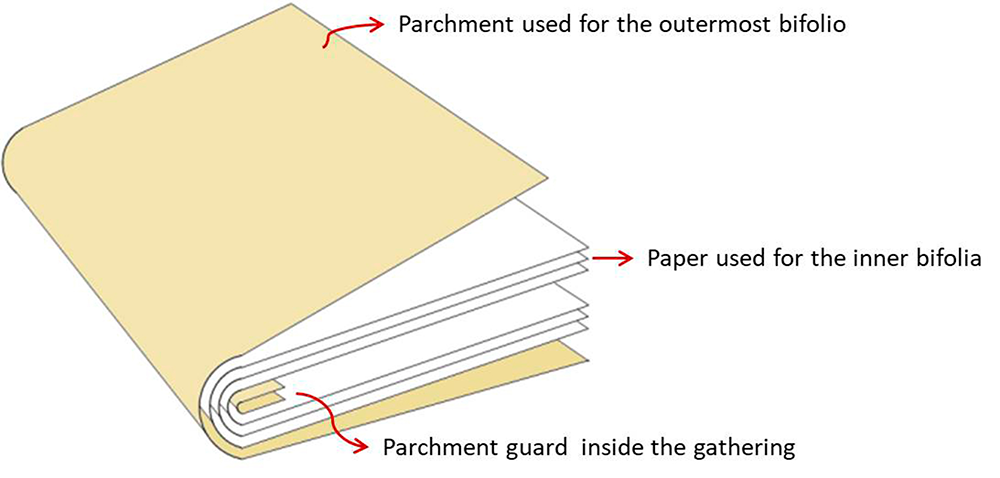Early Attempts to Compensate for the Weakness of Paper in Bookbinding
In the history of European bookbinding, the transition from parchment to paper as the primary material for text leaves caused an associated shift in bookbinding practices, as bookbinders adapted to what they thought of as a weaker material. Parchment is made of animal skin, prepared by dehairing, stretching, scraping, and drying, whereas paper at the time was made of plant-based materials, such as cotton and flax. Throughout the fifteenth century, which also saw an increased demand for books, paper gradually replaced parchment as the main substrate for leaves due to its accessibility and affordability. Although many books were written and printed on paper that we’d consider high quality and very strong today, bookbinders initially struggled to fully rely on the strength and durability of paper in withstanding the stress of the binding process (Szirmai 1999).
The codex book form consists of groups of sheet material, folded and gathered together, and secured along the folded edge (the spine) by sewing and/or adhesive, forming a text block. Sewing is the most common way to secure the gatherings together, which means that the folded sheets have to be pierced, threaded, and pulled tightly together.1 It is not too hard to imagine how much stress is placed on the holes through which the text block is sewn. Since paper was a relatively new material for text blocks, the fifteenth-century binders needed some assurance that the valuable book they produced could stay intact over time. This led bookbinders to add extra protection to the paper gatherings before sewing them together.
An early effort to compensate for paper’s perceived weakness appears in the mixed-use of parchment and paper leaves within one text block. Instead of making the text block fully out of paper, parchment was inserted into the gatherings to reinforce the paper. A full sheet of parchment was placed in the gathering as the outermost folio, while the inner folios were made of paper (Figure 1). In this case, the texts were written on the parchment leaves in the same manner as the paper leaves. In addition, a parchment guard, or a narrow strip of parchment folded in half vertically, could be added inside the innermost fold of each gathering and sewn with the gathering, so that the paper folios are strengthened from inside as well. This type of reinforcement ensured that the sewing would not easily tear through the paper folds.
The Austrian or Czech manuscript binding dated circa 1380–1399, Religious and Philosophical Miscellany (MS M.822; Figure 2), demonstrates this early type of parchment reinforcement. The binding has an inconsistent structure throughout the text block, but the majority of the gatherings have a parchment outermost folio encasing paper inner folios, and a parchment guard (Figures 3–4). The sewn endleaves are also parchment, adding strength to the parts that receive the most stress as the cover board opens and closes.2 The bindery even used recycled material for the guards and the endleaves by using scraps of manuscripts that were no longer in use, so-called manuscript-waste parchment.
As this new iteration of bookbinding with paper text blocks progressed, parchment usage waned over time. The use of a full sheet of parchment as the outermost folio also began to fade as bookbinders found it excessive. However, parchment guards around the folds persisted for a longer while, since they are more cost-effective than using a full sheet and still do the job as a reinforcing feature. The number of parchment guards added varied depending on the level of reinforcement, from guards in every gathering to only one guard in each first and last gathering.
The English manuscript, Miscellany (MS M.818), dated circa 1425–1450 is the example in which I observed the most extensive use of parchment guards (Figure 5). It has guards in every gathering, placed both inside and outside of each gathering (Figures 6, 7, 8). The guards are glued around the spine fold of the section they reinforce, which is possibly done to keep them in place while sewing the text block.
I also encountered another book with parchment guards, less extensive than the previous example, when I received Vnum ex quatuor seu [con]cordia euangelista[rum] (PML 20867) for conservation treatment.
This German incunable was printed in Strasbourg in 1473 and bound by a Carthusian cloister bindery in Trier, Germany. The binding had been treated before, but the front board had detached again, so I had to securely reattach it (Figures 9–10). When I looked closely, manuscript-waste parchment guards were found inside every gathering, but not outside (Figure 11). This time the guards were not glued to the paper leaves.
The first and last paper gatherings are reinforced further by having an additional guard wrapping around the outermost bifolio (Figures 12–13). The first and last gatherings are generally the most vulnerable points among all gatherings as they are situated next to the binding boards and endure the most mechanical stress when the book is opened and closed. The first gathering in books in particular is often found damaged or has missing pages because it is the most frequently accessed part of the book. Figure 12-a shows how the outer guard positions around the last gathering, following the red outline, and Figure 12-b shows the short side of the guard poking out from the gutter. The cutaway diagram in Figure 13 helps to understand the structure of the parchment guards in relation to the text block and the boards. Unfortunately, the front outer guard had to come off from the first gathering after the treatment (Figure 14). I tried to insert it back between the first and second gatherings, but the guard was too short to stay in place. In the end, I decided to leave the guard out of the gatherings and fold it flat, as shown in Figure 14. Although I had to change the original position of this outer guard, I kept written and photographic documentation noting the structural change to inform subsequent users.


Figure 12-a: (top) PML 20867 from the tail end, holding up the last gathering. Note the parchment guard wrapping around the outermost folio of the gathering (red outline).
Figure 12-b: (bottom) Detail of the stub of the parchment guard at the back, poking out between the last and second-to-last gatherings.
The practice of adding parchment guards was reduced at the end of the fifteenth century, until there was one parchment guard around the first and last gatherings of the text block, and no parchment guards in the centerfolds of the gatherings. The two books that will be discussed in Part II are a unique variation of this last type of parchment guard—stay tuned for more.
Yungjin Shin
Pine Tree Foundation Fellow in Book Conservation
Thaw Conservation Center
The Morgan Library & Museum
Endnote
- A gathering is a group of folded leaves that is combined with other gatherings to create a textblock. It is also called quire or section.
- Endleaves are groups of leaves found at each end of a textblock, which are added to protect the text leaves.
Bibliography
- Szirmai, J. A. “Chapter 9 Gothic bindings.” In The Archaeology of Medieval Bookbinding, 173–284. Burlington, VT: Ashgate Publishing Company, 1999.
- Lévêque, Élodie. “7.1.5. Early Gothic Bindings.” In Conservation of Books, 180–182. New York, NY: Taylor & Francis, 2023.
















